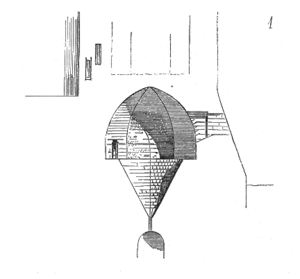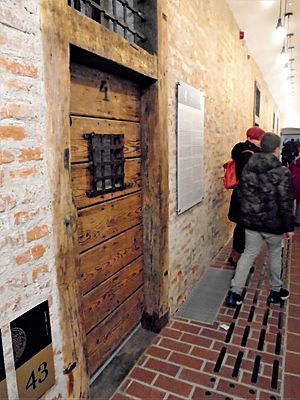Dungeon facts for kids

A dungeon is a room or cell where prisoners are kept. They are often found underground. Dungeons are usually linked with medieval castles. However, the idea of them being used for torture mostly comes from the Renaissance period. An oubliette (from the French word oublier, meaning "to forget") is a special type of basement room. You can only get into it through a hatch or hole in the ceiling.
Contents
What Does "Dungeon" Mean?
The word dungeon comes from the French word donjon. This word means "keep". A keep is the main tower of a castle. The word dungeon first appeared in English around the early 1300s. Back then, it meant the same thing as donjon. So, it meant the main tower.
Today, experts still use "donjon" to mean "keep". But in popular stories and games, "dungeon" usually means a prison cell. It can also mean an oubliette. Both dungeon and donjon might come from the Middle Latin word dominus. This word means "lord" or "master".
In France, donjon still means the main castle tower. The English word "dungeon" often means oubliette in French. This makes them false friends. This means they sound similar but have different meanings. Even the game Dungeons & Dragons is called Donjons et Dragons in French.
The use of "donjons" changed over time. Sometimes they included prison cells. This might explain why the meaning of "dungeon" changed in English. It went from being a prison inside the tallest castle tower to meaning a cell. Later, it even meant an oubliette or a torture room in popular use.
The word oubliette was first used in French in 1374. It first appeared in English in Walter Scott's book Ivanhoe in 1819.
History of Castle Prisons
Not many Norman keeps in English castles had prisons at first. They were more common in Scotland. In the Middle Ages, putting someone in prison was not a common punishment. Most prisoners were waiting for a trial or a political decision. Important prisoners, like nobles, were not usually kept in dark dungeons. They lived comfortably in castle apartments.
The Tower of London is famous for holding political prisoners. Pontefract Castle also held many important people over the years. These included King Richard II and James I of Scotland. Special prison rooms in castles became more common after the 1100s. They were built into gatehouses or towers along the walls. Some castles, like Caernarfon Castle, had larger prison towers.
What Real Dungeons Looked Like
Many real dungeons were just simple rooms. They had a heavy door. Sometimes, the only way in was through a hatchway or trapdoor in the floor above. People often think of dungeons as scary underground places. This is because of stories about them being used for torture. This idea has made dungeons a powerful symbol.
Because of these stories, people often think castles had many more dungeons than they really did. This helps to make castles more interesting for tourists. Many rooms called dungeons or oubliettes were actually water storage areas. Some were even toilets.
An example of a room often called an "oubliette" is at Warwick Castle in central England. It is in Caesar's Tower. This cell is very small and feels very closed-in. The entrance is an iron grate. It would be almost impossible to move around inside this tiny space.
However, this small room is actually a short shaft. It opens into a larger room below. A toilet shaft also enters it from above. This suggests the room might be a partially filled-in drain. Its location in a small alcove is typical for a garderobe (toilet) in medieval buildings. These clues suggest it was likely a toilet, not a prison cell. You can see inside this room in the show Secrets of Great British Castles.
A "bottle dungeon" is sometimes another name for an oubliette. It has a narrow entrance at the top. Sometimes the room below is so narrow you can't lie down. But in other designs, the cell itself is larger.
It's not always easy to tell if a room was a dungeon or a prison. Alnwick Castle and Cockermouth Castle in England had rooms in their gatehouses. These were often thought to be oubliettes. But this idea has been questioned. These underground rooms had no toilets. Since the gatehouses also had living spaces, it's unlikely these rooms were for prisoners. Another idea is that they were strong-rooms. Valuables might have been stored there.
Dungeons in Stories and Games
Oubliettes and dungeons were popular in 19th-century gothic novels and historical novels. They were used to show hidden cruelty and powerful, unfair rulers. These places were usually found under medieval castles or abbeys. Bad characters would use them to harm innocent people. In Alexandre Dumas's La Reine Margot, Catherine de Medici is shown enjoying a victim's suffering in the oubliettes of the Louvre.
Dungeons are very common in modern fantasy books and games. The most famous example is the Dungeons & Dragons game series. In these games, "dungeon" often means any complex underground area. This could be a castle, a cave system, or something else. It doesn't always mean a prison cell or a torture room. A role-playing game where you explore a dungeon is called a dungeon crawl.
In Jack Vance's Lyonesse Trilogy, King Casmir puts Prince Aillas in an oubliette. The king thinks Aillas is just a wanderer. After a few months, the clever prince makes a ladder from old bones and a rope. He then escapes.
In the movie Labyrinth, the director Jim Henson shows the heroine Sarah being freed from an oubliette. The dwarf Hoggle tells her it's "a place you put people... to forget about 'em!"
In the novel The Silence of the Lambs by Thomas Harris, Clarice goes into Gumb's basement dungeon. The killer is described as having an oubliette there.
In the novel Stranger in a Strange Land by Robert A. Heinlein, the word "oubliette" is used for a trash disposal. It's like the "memory holes" in Nineteen Eighty-Four.
See also
 In Spanish: Calabozo para niños
In Spanish: Calabozo para niños



